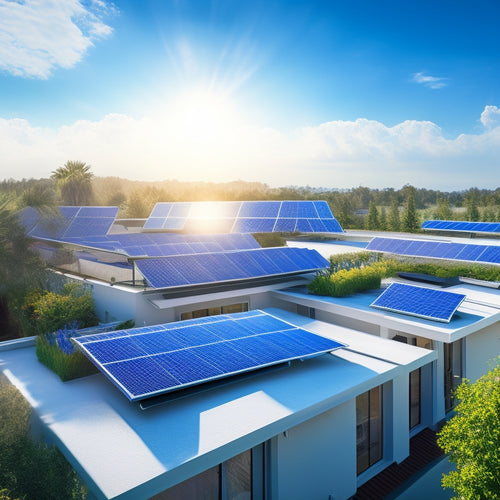
Building a Solar Power System for Your Home in 5 Steps
Share
You'll start by evaluating your energy needs, reviewing past utility bills to determine your average daily energy usage in kWh and identifying energy-intensive appliances. Next, you'll choose the right solar panels for your system, considering factors like efficiency ratings and cost. Then, you'll plan your system configuration, factoring in roof orientation, tilt, and shading, as well as deciding on power storage options. After that, you'll install and connect your system, ensuring proper inverter placement and wiring. Finally, you'll monitor and maintain performance, tracking energy production and consumption in real-time and performing routine tasks to maximize energy output - and that's just the beginning of your solar power expedition.
Key Takeaways
- Assess your energy needs by reviewing past utility bills and identifying energy-intensive appliances to determine the required system size.
- Choose the right solar panels based on efficiency, cost, and energy output, considering monocrystalline, polycrystalline, and thin-film options.
- Plan the system configuration, including panel layout, power storage, and inverter selection, to ensure optimal performance and efficiency.
- Install and connect the system, following manufacturer instructions and local codes, to ensure safe and efficient energy production.
- Monitor and maintain the system's performance, tracking energy production and consumption, and performing regular inspections and maintenance tasks.
Assess Your Energy Needs
About 90% of homeowners considering solar power systems wonder how much energy they need to generate to power their homes efficiently. To determine your energy needs, you'll need to evaluate your energy consumption.
Start by reviewing your past utility bills to identify your average daily energy usage in kilowatt-hours (kWh). This will give you a baseline to work from. Next, consider your energy-intensive appliances and habits, such as refrigeration, air conditioning, and electronics usage.
You may want to upgrade to energy-efficient alternatives to reduce your overall energy consumption. Additionally, think about your energy goals: do you want to power your entire home, or just a portion of it?
Choose Your Solar Panels
How efficiently will your solar power system convert sunlight into electricity? The answer lies in the type of solar panels you choose. There are three main solar panel types: monocrystalline, polycrystalline, and thin-film.
Monocrystalline panels are the most efficient, with efficiency ratings ranging from 17% to 22%. Polycrystalline panels are a close second, with efficiency ratings between 15% and 20%. Thin-film panels, on the other hand, have lower efficiency ratings, typically ranging from 7% to 14%.
When selecting solar panels, consider the efficiency rating, which is measured by the amount of sunlight converted into electricity per hour. Higher efficiency ratings mean more power output per unit area. For example, a 300-watt panel with a 20% efficiency rating will produce more power than a 300-watt panel with a 15% efficiency rating.
Look for panels with high efficiency ratings and a proven track record of performance. Keep in mind that higher-efficiency panels often come at a higher cost.
Weigh the benefits of increased power output against the added expense to determine the best fit for your solar power system.
Plan System Configuration
Now that you've chosen your solar panels, it's time to think about how they'll work together to generate power for your home. This is where you'll plan your system configuration, ensuring that every component is optimized for maximum energy production.
You'll need to determine the system layout, considering factors like the orientation and tilt of your roof, shading from trees or buildings, and the available space for your solar array. A well-designed layout will help you get the most out of your solar panels.
Next, you'll need to decide on power storage. Will you opt for a grid-tied system, which sends excess energy back to the grid and allows you to draw from it when needed? Or will you choose a battery-based system, which stores excess energy for later use?
Your power storage solution will depend on your energy needs, budget, and local regulations.
Take your time to plan your system configuration carefully, as it will have a significant impact on your system's performance and efficiency. With a well-planned configuration, you'll be able to generate clean, renewable energy and enjoy the benefits of solar power.
Install and Connect System
You've finalized your system configuration, and it's time to bring your solar power system to life. This step requires careful planning and execution to guarantee a safe and efficient installation.
Begin by installing the solar inverter, which converts DC power from your solar panels to AC power for your home. Ascertain the inverter is installed in a well-ventilated area, away from direct sunlight and moisture.
Next, focus on making the necessary wiring connections. This includes connecting the solar panels to the inverter, and the inverter to your electrical panel. Make sure to follow the manufacturer's instructions and local electrical codes to avoid any safety hazards.
- Connect the solar panels to the inverter using MC4 connectors or other approved connectors.
- Run the wiring from the inverter to your electrical panel, verifying it's properly sized and rated for the system's power output.
- Connect the inverter to your electrical panel, following the manufacturer's instructions and local electrical codes.
Monitor and Maintain Performance
With your solar power system up and running, it's essential to keep a close eye on its performance to guarantee you're maximizing your energy output and identifying any potential issues early on.
Performance tracking is key to ensuring your system operates at peak levels. You'll want to monitor your system's energy production, consumption, and storage in real-time. This can be done using a monitoring system that provides detailed data on your system's performance, allowing you to identify areas for improvement.
To maintain your system's performance, you'll need to establish a regular maintenance schedule. This should include routine inspections of your system's components, such as the solar panels, inverters, and mounting structures.
You'll also want to perform tasks like cleaning the solar panels, checking for loose connections, and ensuring the system is securely grounded.
Frequently Asked Questions
Can I Install a Solar Power System Myself or Do I Need a Professional?
You can attempt a DIY installation, but consider the safety considerations: electrical shock, roof damage, and warranty voidance. Unless you're experienced in electrical work, it's recommended you hire a professional to guarantee a safe and efficient solar power system installation.
Will My Homeowners' Association Allow Me to Install Solar Panels?
You'll need to review your HOA's regulations, like the California couple who successfully installed solar panels despite initial resistance, by ensuring compliance with solar panel guidelines, such as size, color, and roof integration.
Are There Any Government Incentives for Installing Solar Power Systems?
You're eligible for federal rebates and state incentives when installing solar power systems, which can greatly reduce your upfront costs; research and claim these benefits to maximize your return on investment.
Can I Use Solar Power to Charge My Electric Vehicle?
Ditch the gas guzzler! You can utilize the sun's energy to fuel your electric vehicle, seamlessly integrating solar charging into your daily routine, and slashing your carbon footprint in the process.
Will Solar Panels Increase My Property Value?
You'll be pleased to know that your solar investment will likely enhance your property value, as a property appraisal will reflect the increased worth, making your home more attractive to potential buyers if you decide to sell.
Related Posts
-

Why Certification Matters for Residential Panels
You're looking to understand why certification matters for residential panels. Basically, third-party certification g...
-

Top Online Stores for Solar Car Accessories
When searching online for solar car accessories, you'll find top retailers like Amazon, REI Co-op, and Best Buy offer...
-

Best Solar Panel Options for Maximum Energy Savings
You can maximize your energy savings with solar panels that boast efficiency ratings above 20%, paired with extensive...


